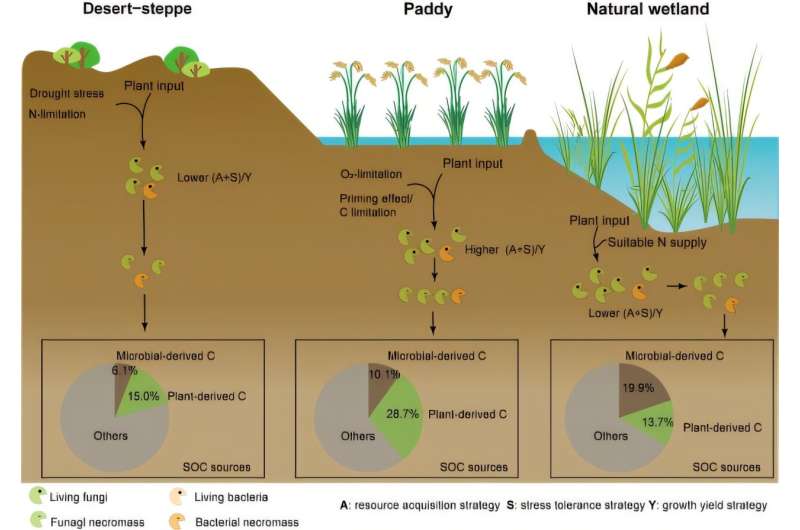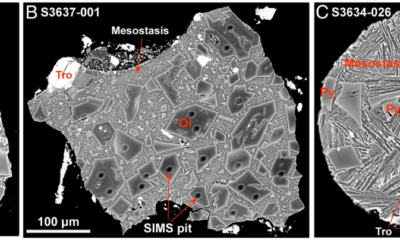Science
New Study Reveals Soil Carbon Dynamics in Hyper-Arid Regions

A recent study conducted by a team from the Xinjiang Institute of Ecology and Geography, part of the Chinese Academy of Sciences, has identified distinct mechanisms of soil organic carbon (SOC) accumulation in hyper-arid regions. Published in the journal Agriculture, Ecosystems and Environment on November 5, 2025, the research highlights the variations in SOC across different land-use types in the southern Taklimakan Desert.
The researchers examined three ecosystems: natural wetlands, paddies, and desert steppes. Utilizing advanced analytical methods, including amino sugar and lignin phenol biomarker analysis, enzyme activity assays, and metagenomic sequencing, they discovered unique sources of SOC and the microbial processes responsible for these findings.
Natural wetlands emerged as the most significant contributors to SOC, with microbial necromass carbon accounting for up to 19.9% of the total carbon, primarily derived from fungal necromass. In stark contrast, paddies displayed the lowest SOC levels, where plant-derived carbon constituted 28.7%, increasing the risk of priming effects that accelerate the mineralization of existing SOC. The study also noted that desert steppes, affected by drought stress and nutrient constraints, showed minimal microbial necromass accumulation and the highest levels of lignin oxidation, leading to less stable carbon in the soil.
Dr. Zhang Zhihao, the first author of the study, emphasized the importance of microbial life-history strategies in regulating SOC pool stability in these arid environments. “Our work clearly identified that microbial life-history strategy—the patterns of growth, reproduction, and survival that microbes employ in a given environment—is the key factor regulating SOC pool stability in hyper-arid regions,” he stated.
The findings underscore the vital role of natural wetlands in maintaining carbon sinks in dryland ecosystems. The researchers recommend that paddy management practices focus on controlling salinity and ensuring balanced fertilization to enhance long-term soil carbon sequestration.
This study presents critical insights into soil carbon dynamics, shedding light on how microbial processes can influence carbon stability in extreme environments. As climate concerns continue to rise, understanding these mechanisms becomes increasingly essential for developing effective land management strategies.
For further details, see the study by Zhihao Zhang et al, titled “Divergent soil organic carbon accrual from plant and microbial sources across ecosystem types in a hyper-arid oasis-desert ecotone,” published in Agriculture, Ecosystems and Environment.
-

 Technology4 months ago
Technology4 months agoDiscover the Top 10 Calorie Counting Apps of 2025
-

 Health2 months ago
Health2 months agoBella Hadid Shares Health Update After Treatment for Lyme Disease
-

 Health3 months ago
Health3 months agoErin Bates Shares Recovery Update Following Sepsis Complications
-

 Technology3 weeks ago
Technology3 weeks agoDiscover 2025’s Top GPUs for Exceptional 4K Gaming Performance
-

 Technology4 months ago
Technology4 months agoDiscover How to Reverse Image Search Using ChatGPT Effortlessly
-

 Technology2 months ago
Technology2 months agoElectric Moto Influencer Surronster Arrested in Tijuana
-

 Technology4 months ago
Technology4 months agoMeta Initiates $60B AI Data Center Expansion, Starting in Ohio
-

 Technology4 months ago
Technology4 months agoRecovering a Suspended TikTok Account: A Step-by-Step Guide
-

 Health4 months ago
Health4 months agoTested: Rab Firewall Mountain Jacket Survives Harsh Conditions
-

 Lifestyle4 months ago
Lifestyle4 months agoBelton Family Reunites After Daughter Survives Hill Country Floods
-

 Technology3 months ago
Technology3 months agoUncovering the Top Five Most Challenging Motorcycles to Ride
-

 Technology4 weeks ago
Technology4 weeks agoDiscover the Best Wireless Earbuds for Every Lifestyle



















